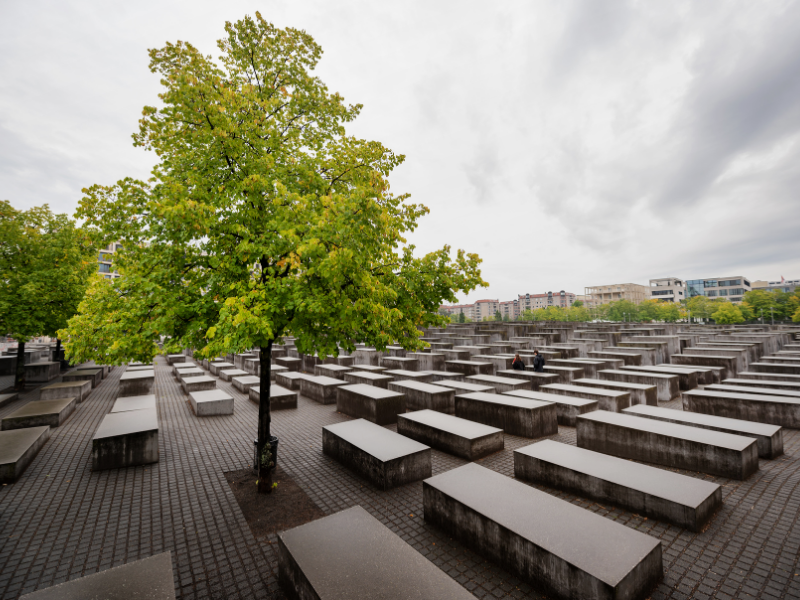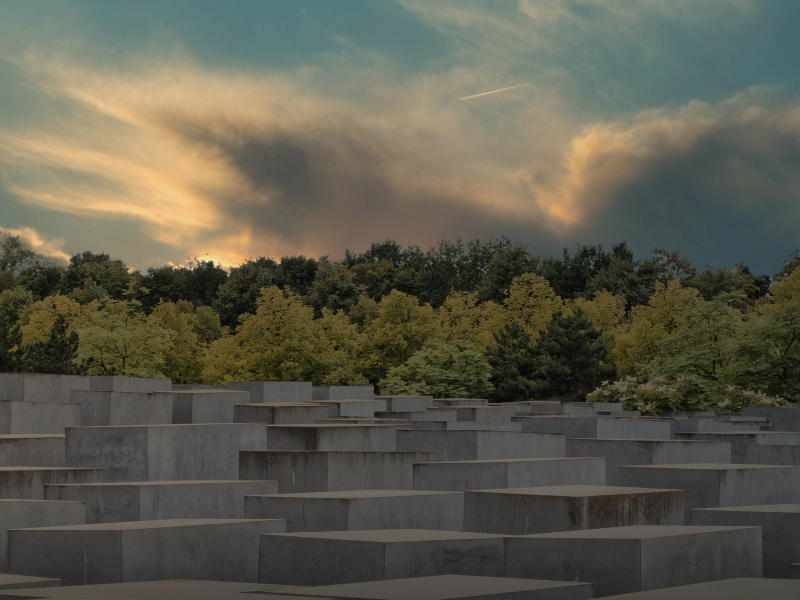The Memorial for the Murdered Jews of Europe, commonly known as the Holocaust Memorial, is a moving tribute to the six million innocent people exterminated during the Second World War. It is sited in Berlin and serves as a strong reminder of war crimes committed there while also acting as a place for meditation and remembrance.
Historical Context
Origin and Construction
Lea Rosh, a German journalist first suggested the idea of establishing The Memorial for the Murdered Jews of Europe in 1988. After ten years full of controversies over various designs among other factors that hindered its realization process some were even destroyed by natural calamities like floods or fires; finally American architect Peter Eisenman’s proposal won after being chosen among many others during an international competition held in 1997.Construction work began three years later followed by official opening on May 10th 2005 which marked sixty years since end WW2 (World War Two) European theatre. It was created so that Jewish victims could be remembered always but more importantly never repeated again.
Purpose and Dedication
This place aims primarily at being used for remembrance activities as well as education purposes too therefore serving these functions excellently would help achieve them effectively hence becoming successful altogether.It is dedicated to six million Jews who died because they were killed systematically under Nazi regime between 1941-1945.The area invites all people visiting there not only concentrate on what were done but also try realizing how heavy loss occurred within Jewish community.
Significance
Many see The Memorial for the Murdered Jews of Europe not just as another holocaust memorial but also an everlasting evidence showing that Germany has continuously been recognizing her past atrocities thus making such horrific events impossible here again in future .It has been integrated into wider landscape Berlin city thereby representing significance attached to remembering past evils and enlightening current generations about them.

Architecture and Design Features
Design Concept
The design of this memorial is abstract in nature which means it can be interpreted differently by different people. It consists 2700 concrete blocks arranged on sloping ground forming a grid pattern or maze like layout.Peter Eisenman who was the architect responsible for designing it intended that visitors should feel confused when walking through those paths since they were supposed to create sense instability as well disorientation particularly among those affected most during holocaust period.
Structure and Layout
Rows narrow paths are formed between stelae such that one feels like he or she going round circles while trying find their way out.The unevenness if ground beneath adds more confusion because you don’t know where exactly you are in relation other parts of building .There is no specific symbolism represented by each path thus leaving everyone with freedom choose his own interpretation while engaging with what happened here many years ago.
Symbolic Elements
Though intentionally vague many see heights various slabs as symbolic representation human lives lost during holocaust; every single life being unique but at same time part bigger tragedy.The complex nature these alleys also signifies complexity involved around carrying out such massive killings therefore encouraging individuals reflect upon enormity crimes committed against humanity.
Information Centre
Overview Information Center
Underneath field stelae lies underground information centre which provides historical context together with personal stories relating to holocaust.This centre was opened along side memorial year 2005 so as help people understand more about events leading up this phase history as well its impact on mankind.
Exhibits and Displays
The Information Centre is divided into different rooms that are based on the various aspects of the Holocaust. These are:
Room of Dimensions: This room features letters, diary entries and final notes by victims to show individual experiences behind statistics.
Room of Families: It tells stories about Jewish families before, during and after the Holocaust to demonstrate how it destroyed entire communities.
Room of Names: In this touching exhibit, names as well as brief biographies of holocaust victims are continuously read out loud.
Room of Sites: On display here are photos as well as information about major places where persecution took place; these also give geographical and historical context.
Interactive Features
The Information Centre has interactive displays which enable visitors to have a more hands-on experience with the exhibits. Multimedia presentations include video testimonies from survivors that provide personal insights into what happened during this period in history. There are educational resources available too – detailed historical documents provide an extensive understanding of events surrounding World War II.

Visiting the Memorial
Location and Access
The Memorial for the Murdered Jews of Europe is located at a central position within Berlin near Brandenburg Gate and Reichstag Building. It can be reached easily using public transport:
- By Metro: The nearest U-Bahn station is Mohrenstrasse (U2) which is only a short walk away from the memorial site.
- By Train: S-Bahn lines S1, S2 & S25 all stop at Brandenburger Tor station which is also close by.
- By Bus: A number of bus routes including 100 and 200 stop nearby to the memorial site.
Operating Hours and Fees
The memorial is open all the time and can be visited free of charge. The Information Center has specific opening hours, usually from 10 am to 8 pm, with the last entry at 7:15 pm.
Ideal Time to Visit
To fully understand the memorial’s significance, it is advisable to visit during early morning hours or late afternoon when there are fewer people. Weekdays tend to be less busy than weekends. The place is extremely powerful in the first light of day or at dusk when everything becomes soft and reflective.
Exploring the Memorial
Walking Through the Stelae
Walking through the grid of stelae can be a disorienting and emotional experience. Narrow paths and uneven heights create an atmosphere of solitude and contemplation. The design of this monument encourages us to think about our own suffering as well as that suffered by others who were victims during the Holocaust.
Engaging with the Information Center
The information center located below ground level offers essential background knowledge which enriches ones’ experience while there as a visitor. Do take some time going around all these displays – they tell stories about real people’s lives which should never be forgotten because they represent different aspects pertaining to personal costs arising from such genocides like this one here too where so many millions died unnecessarily due mainly hate alone being shown towards them . Besides text panels, models etc., it includes interactive installations together with multimedia presentations so that everyone can get closer not only visually but emotionally too towards historical facts connected with those tragic events.
Reflecting And Respecting
This monument stands as both a symbolization remembering what happened during those years but also allows for personal reflection on ones life or society in general . Visitors should therefore conduct themselves respectfully while moving around this area . Remember it is allowed taking pictures; however, keep in mind that these are graveyards thus deserve some decorum from us.
Map
Nearest Sightseings
Brandenburg Gate
The Brandenburg Gate is just a short walk from the Holocaust Memorial. One of the most iconic landmarks in Berlin, this neoclassical monument has seen many significant events throughout history and stands today as an internationally recognized symbol for peace. It offers wider historical context to any visit one could make here before or after their journey towards other parts associated with such dark periods .
Reichstag Building
The Reichstag Building, which houses the German Parliament (Bundestag), can also be found nearby. You are able to go on guided tours through it; furthermore there exists possibility climbing up into its glass dome where you will be rewarded panoramic views over Berlin city centre . From being destroyed during WW II until becoming home again for Federal Assembly representatives after reunification – all those stages in life give additional meaning behind what happened during WWII if compared only against those provided by memorial alone .
Topography of Terror
The Topography of Terror is located close to the Holocaust Memorial. This outdoor and indoor museum documents Nazi history at its former SS and Gestapo Headquarters site with a permanent exhibition that covers everything from Hitler’s rise to power through to World War Two crimes against humanity . Additionally there are many temporary displays which help provide further understanding into when & why such things took place hereabouts.
Recommendations for a Memorable Visit
Photography Tips
- Indoor Lighting: The stelae are outside but early morning or late afternoon offer better light for photographing them.
- Exterior Shots: Capture the contrast between the memorial and surrounding cityscape – best done at either end of day when there’s still some sunlight left in the sky.
- Respectful Photography: Remember this is a place of remembrance so try not to take selfies etc., while photographing



